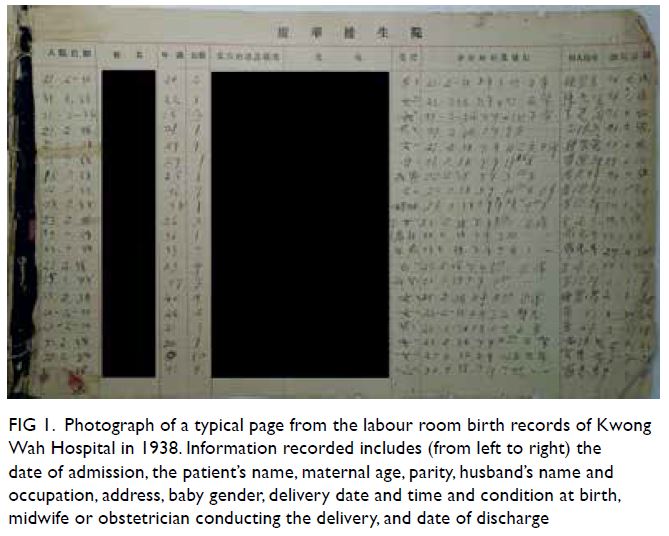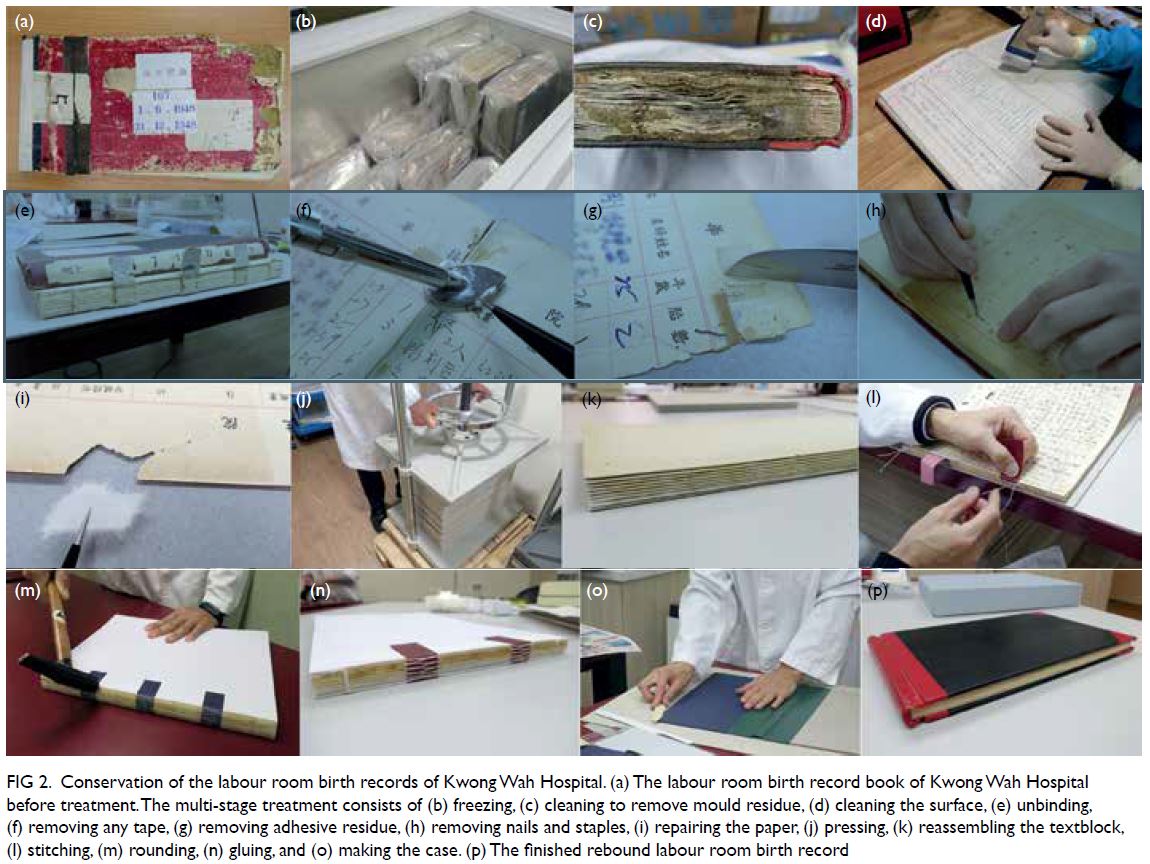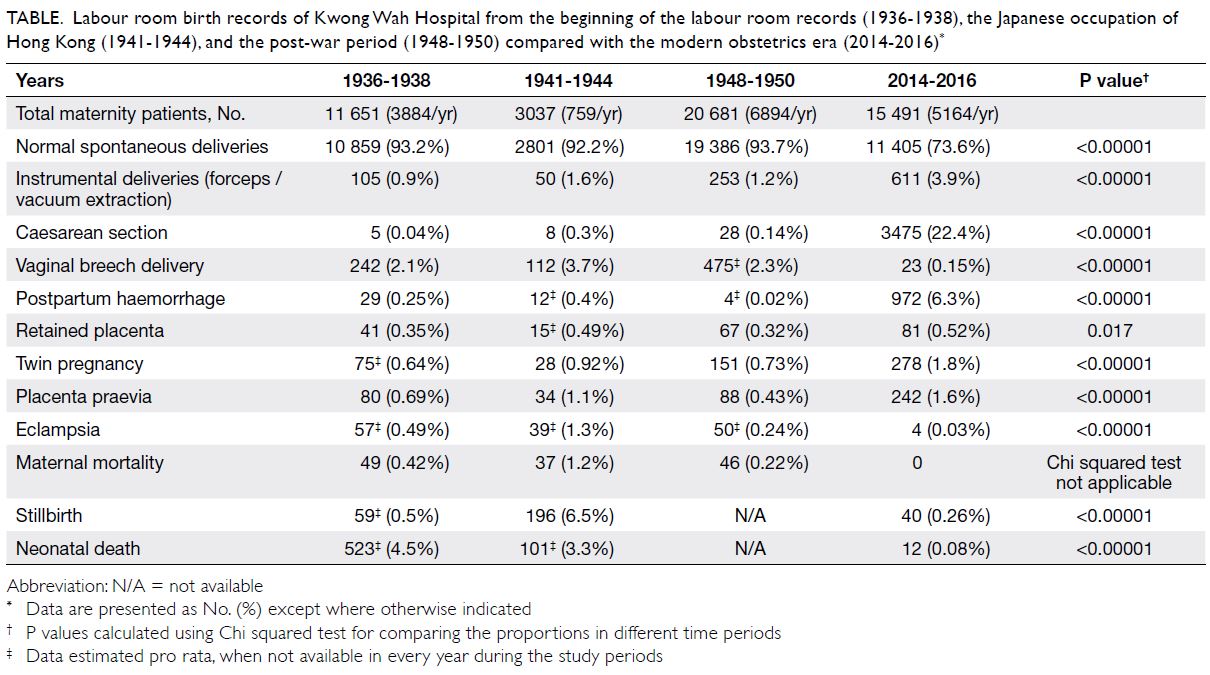Hong Kong Med J 2021 Oct;27(5):374–6 | Epub 20 Oct 2021
© Hong Kong Academy of Medicine. CC BY-NC-ND 4.0
COMMENTARY
Labour room birth records of Kwong Wah
Hospital since 1935
WC Leung, MD, FHKAM (Obstetrics and Gynaecology)1; SM Tai, BHSc, MSSc1; Alice Sham, BN, MSSc1; Winnie Yip, BA, MA2; Stella See, BA2
1 Department of Obstetrics and Gynaecology, Kwong Wah Hospital, Hong Kong
2 Records and Heritage Office, Tung Wah Group of Hospitals, Hong Kong
Corresponding author: Dr WC Leung (leungwc@ha.org.hk)
This year marks the 110th anniversary of the
foundation of Kwong Wah Hospital. As the first
hospital on the Kowloon Peninsula, Kwong Wah
Hospital was closely connected with the Tung Wah
Hospital established under the Chinese Hospital
Incorporation Ordinance1 promulgated in 1870 as
the first hospital on Hong Kong Island providing free
Chinese medicine care to the indigent Chinese.
On 24 August 1911, the Government
promulgated the Tung Wah Hospital Extension
Ordinance2 whereby Kwong Wah Hospital was established as a Kowloon branch of the Tung Wah
Hospital. It was on the basis of this Ordinance that
the amalgamation of three Tung Wah Hospitals
came into being in 1931 as the “Tung Wah Group of
Hospitals”, after the establishment of the Tung Wah
Eastern Hospital in So Kon Po on Hong Kong Island
in 1929.
Kwong Wah Hospital was officially opened on
9 October 1911. Unlike Tung Wah Hospital, which
initially provided only traditional Chinese medicine
care, Kwong Wah Hospital provided both Chinese
and Western medicine care from the very beginning.
In 2011, the Administrative Services
Department of Kwong Wah Hospital approached the
Records and Heritage Office of the Tung Wah Group
of Hospitals to invite advisers and members of the
Records and Heritage Committee to give advice
on preservation of some very old records in their
Records Office. With participation from academics
and the Director of the Conservation Office of
the Leisure and Cultural Services Department
the archives were accorded high importance for
safeguarding the medical heritage of Hong Kong.
Thus, it was decided that Kwong Wah Hospital
would avail the earliest available hospital register
of 1917 for Tung Wah Group of Hospitals and the
Leisure and Cultural Services Department to launch
an experimental conservation project to restore the
first registry. The project was successfully completed
in early 2012. Tung Wah allocated funds to continue
to conserve the remaining 157 items of Chinese-style
hospital registers.
In 2016, Kwong Wah Hospital sought the
agreement of the Hospital Authority to transfer 1249 items of records of the hospital from 1917
to 1991 (before the hospital joined the Hospital
Authority) to the Records and Heritage Office
for permanent custody. In addition to the large
collection of hospital registers, in which the patient’s
name, hometown, address, age, symptoms, and other
information were recorded, there were 377 items
of birth records from 1935 to 1991, in which the
mother’s name, age, address, number of births,
husband’s profession, and other information were
recorded. The condition of some of these archives
was extremely poor (Fig 1). The Records and
Heritage Office arranged for conserving (Fig 2) and
digitising the records. The full set of digital birth
records provided to Kwong Wah Hospital enable the
answering of hundreds of enquiries from the public
each year regarding birth information. All 1249 items
in the archives are now kept in the TWGHs Maisy
Ho Archives and Relics Centre as part of the Group
archives.

Figure 1. Photograph of a typical page from the labour room birth records of Kwong Wah Hospital in 1938. Information recorded includes (from left to right) the date of admission, the patient’s name, maternal age, parity, husband’s name and occupation, address, baby gender, delivery date and time and condition at birth, midwife or obstetrician conducting the delivery, and date of discharge

Figure 2. Conservation of the labour room birth records of Kwong Wah Hospital. (a) The labour room birth record book of Kwong Wah Hospital before treatment. The multi-stage treatment consists of (b) freezing, (c) cleaning to remove mould residue, (d) cleaning the surface, (e) unbinding, (f) removing any tape, (g) removing adhesive residue, (h) removing nails and staples, (i) repairing the paper, (j) pressing, (k) reassembling the textblock, (l) stitching, (m) rounding, (n) gluing, and (o) making the case. (p) The finished rebound labour room birth record
In the present Commentary, we look at the labour room birth record archives from 1935 and
compare these historical data with similar data from
modern day obstetrics.
The labour room birth records started in 1935
most likely to facilitate the amendment of the Births
and Deaths Registration Ordinance3 in 1934 which
encouraged the registration of all births and the
issue of birth certificates at no cost to the patient, as
well as to facilitate vaccination.
From the data available, we selected four
periods to compare the labour room birth records:
the beginning of labour room birth records (1936-1938); the Japanese occupation of Hong Kong during
the Second World War (1941-1944); the post-war
period (1948-1950); and the modern obstetrics era
(2014-2016) [Table].4

Table. Labour room birth records of Kwong Wah Hospital from the beginning of the labour room records (1936-1938), the Japanese occupation of Hong Kong (1941-1944), and the post-war period (1948-1950) compared with the modern obstetrics era (2014-2016)
Compared with the historical data, in
modern obstetrics there were significant decreases
in maternal mortality and neonatal death, which
are obviously related to healthcare improvements
in modern obstetrics and neonatal intensive care
unit support. The same applied to the significant
reduction of eclampsia in modern obstetrics. In
contrast, increasing use of interventions such as instrumental deliveries and Caesarean sections
in modern obstetrics has resulted in a significant
reduction in normal vaginal deliveries, nowadays
known as medicalisation of childbirth. This includes
vaginal breech deliveries after the Term Breech Trail
by Hannah et al5 showed the higher risk of vaginal
breech delivery to the newborns. The first Caesarean
section in Kwong Wah Hospital was performed on 24
April 1937, according to labour room birth records.
Compared with the historical data, in modern
obstetrics there have been significant increases in
postpartum haemorrhage and retained placenta
(might be the result of different definitions and
accuracy of documentation), as well as twin
pregnancies (definitely related to the invention
of assisted reproduction technology in modern
era). The significant increase in placenta praevia in
modern obstetrics did worth special mentioning. A
major contributing factor is the increasing Caesarean
section rate. Note that placenta praevia together
with previous Caesarean section could result in placenta accreta, which has been described to be a 20th century iatrogenic uterine disease.6
Kwong Wah Hospital continued offering free clinical service during wartime, but there were far
fewer pregnancies or maternities than before or after
the war. The expected difficulty for pregnant women
to access to hospital could explain the significant
increases in maternal mortality and stillbirths during
wartime.
Author contributions
All authors contributed to the concept or design of the study,
acquisition of data, analysis or interpretation of data, drafting
of the manuscript, and critical revision of the manuscript for
important intellectual content. All authors had full access to
the data, contributed to the study, approved the final version
for publication, and take responsibility for its accuracy and
integrity.
Conflicts of interest
All authors have disclosed no conflicts of interest.
Acknowledgement
Special thanks to Records and Heritage Office and Maisy Ho
Archives and Relics Centre, Tung Wah Group of Hospitals
for providing the history of Kwong Wah Hospital and
conservation of the labour room birth records from 1935.
Declaration
Some of the findings from this study were presented on 7
September 2019 as part of a series of talks titled “Charity
and Healthcare: Tung Wah Archives and Hong Kong’s Early
Healthcare Development” (https://www.tungwah.org.hk/en/heritage-news/subject-talks-and-roving-exhibitions-incharity-and-healthcare-tung-wah-archives-and-hong-kongs-early-healthcare-development/).
Funding/support
This study received no specific grant from any funding agency in the public, commercial, or not-for-profit sectors.
References
1. The Chinese Hospital Incorporation Ordinance. 1870.
2. The Tung Wah Hospital Extension Ordinance. 1911.
3. The Births and Deaths Registration Ordinance. 1934.
4. Annual Obstetrics Report 2014 to 2016. Department of Obstetrics & Gynaecology, Kwong Wah Hospital, Hong Kong SAR Government.
5. Hannah ME, Hannah WJ, Hewson SA, Hodnett ED,
Saigal S, Willan AR. Planned caesarean section versus
planned vaginal birth for breech presentation at term:
a randomised multicentre trial. Term Breech Trial
Collaborative Group. Lancet 2000;356:1375-83. Crossref
6. Jauniaux E, Jurkovic D. Placenta accreta: pathogenesis
of a 20th century iatrogenic uterine disease. Placenta
2012;33:244-51. Crossref

